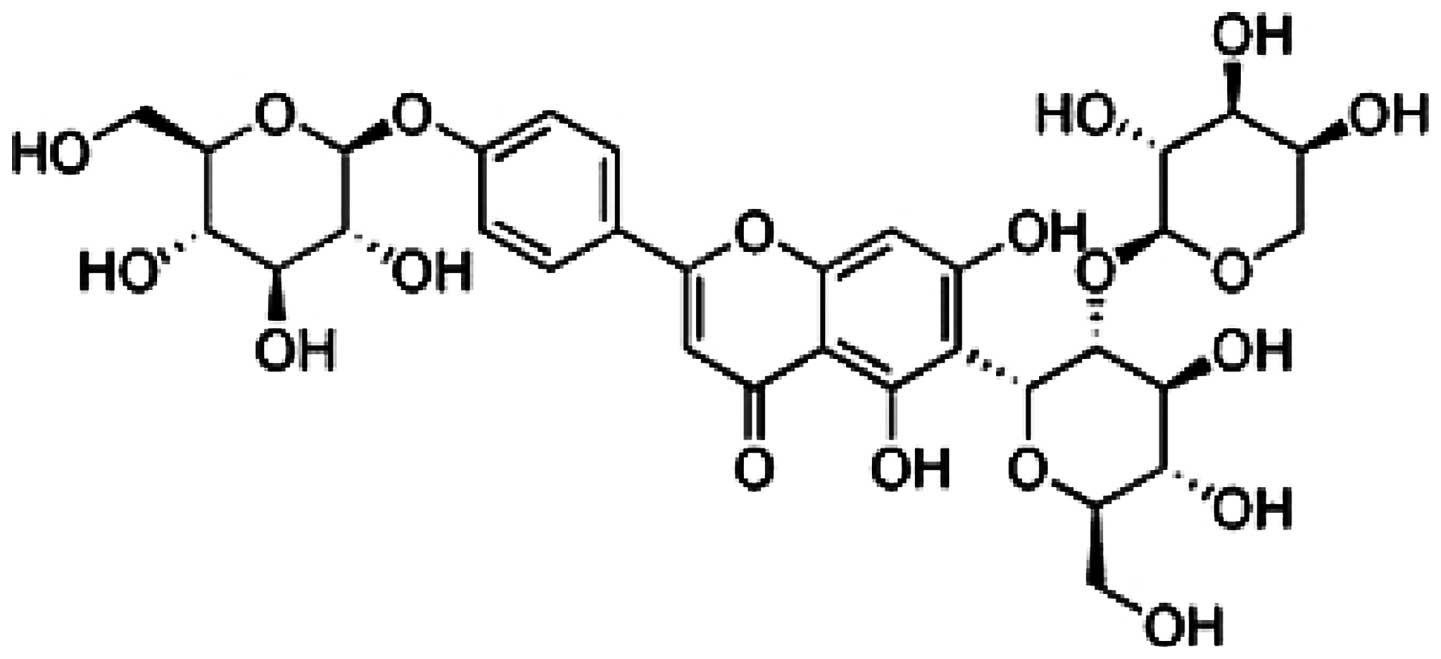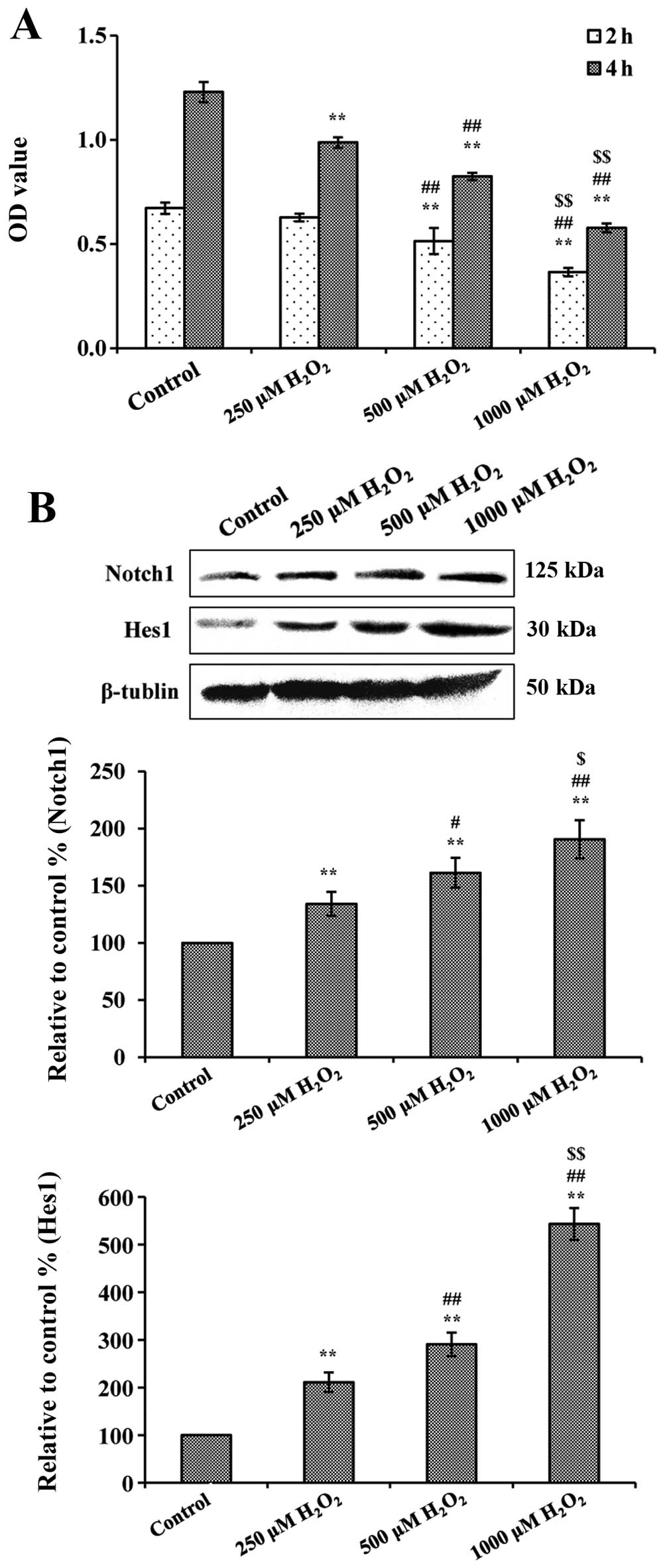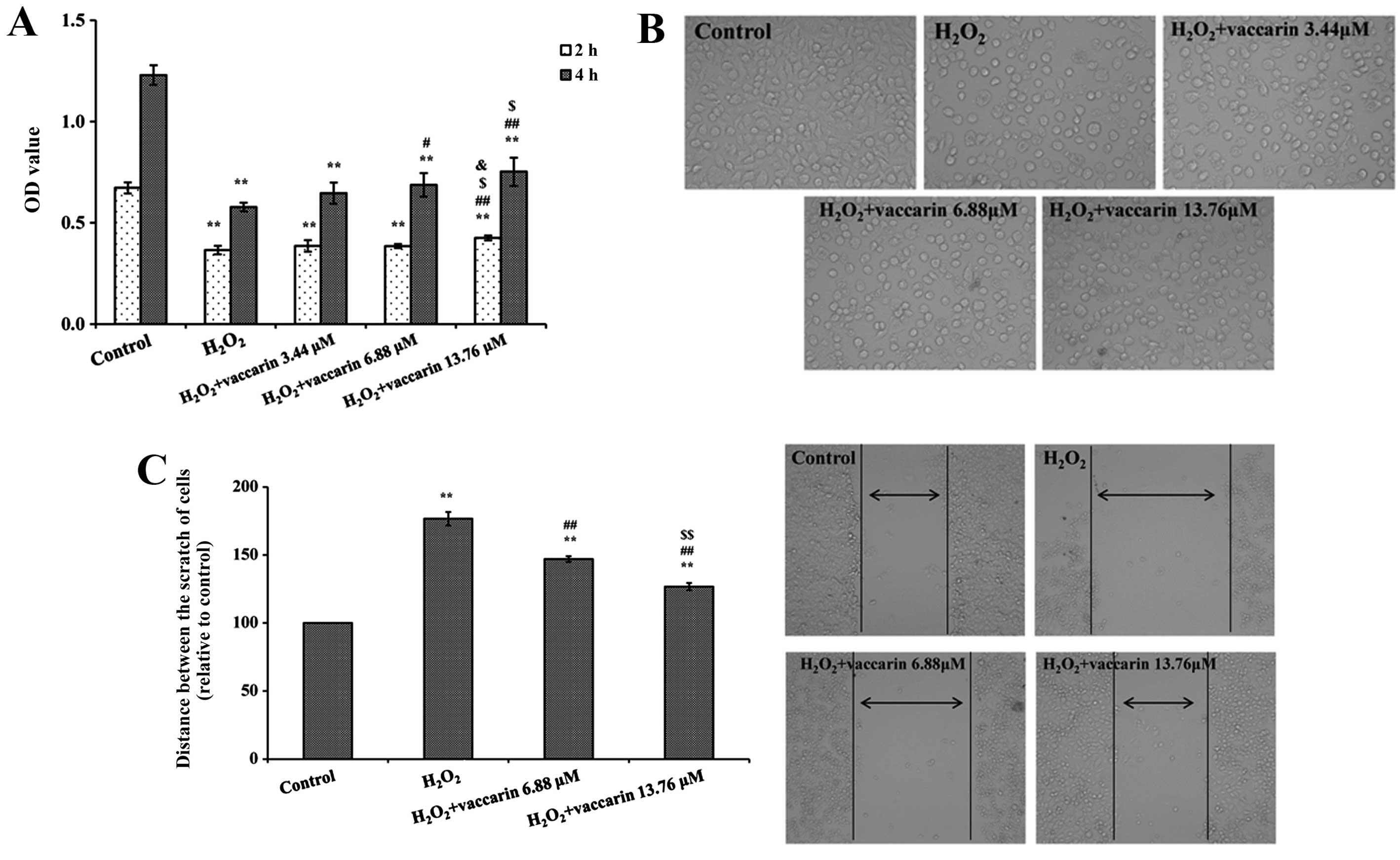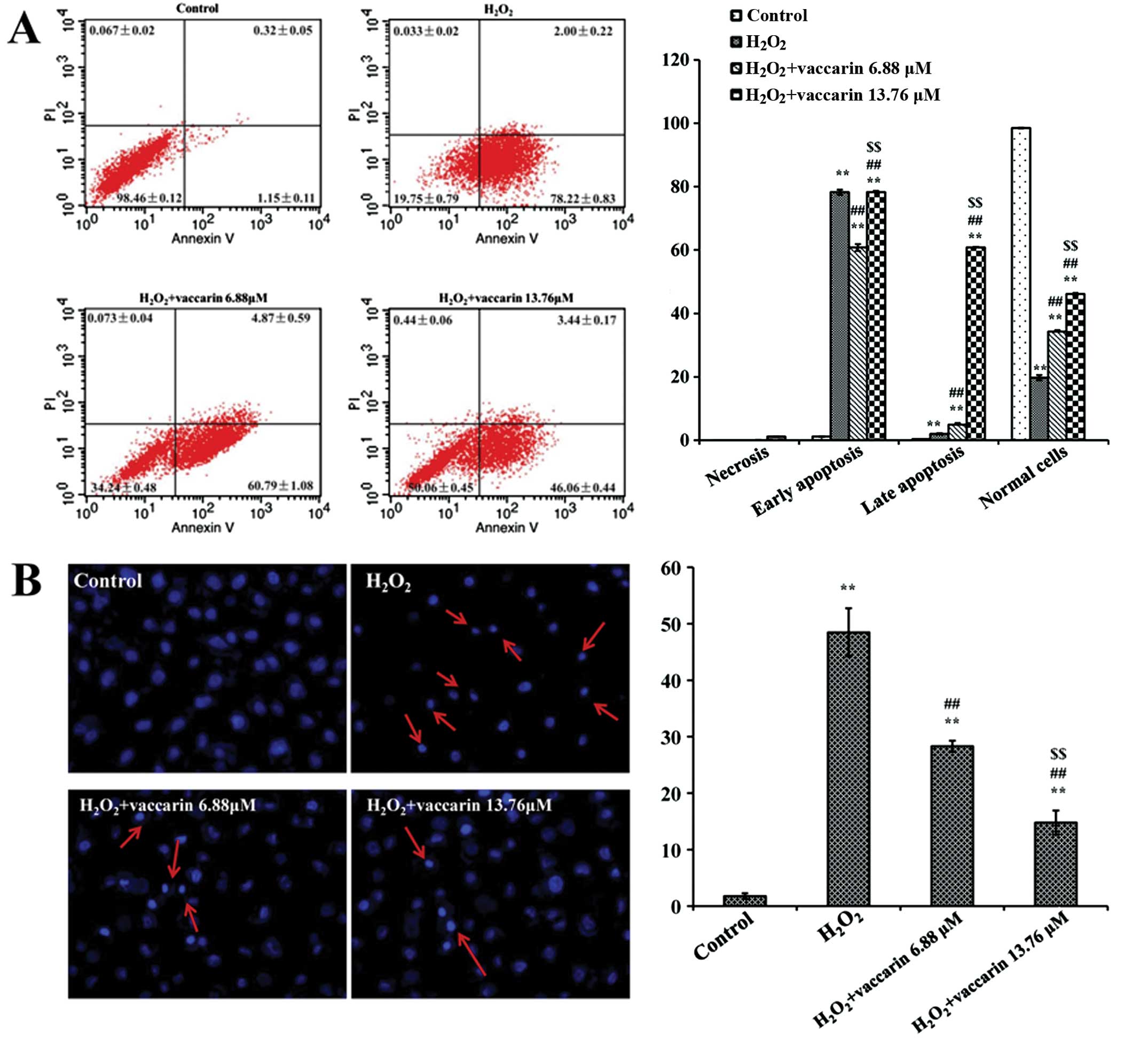Vaccarin attenuates the human EA.hy926 endothelial cell oxidative stress injury through inhibition of Notch signaling
- Authors:
- Published online on: October 23, 2014 https://doi.org/10.3892/ijmm.2014.1977
- Pages: 135-142
Abstract
Introduction
Macrovascular diseases, such as atherosclerosis, are the most frequent complications of diabetes (1). Diabetes mellitus impairs endothelial function and may be an indicator of the cardiovascular disease development (2,3). Vascular endothelium is considered to play an essential role in diabetes-associated vascular dysfunction, including atherosclerosis (4). The endothelium plays a significant role in the regulation of vascular function and the development of physiological and pathophysiological inflammation (5–8). Endothelial cell injury is a critical element of atherosclerosis and hypertension (9,10). Previous studies have shown that H2O2 induced endothelial cell apoptosis, and causes cellular dysfunction and cell death (11,12). The vascular function pathogenesis is complicated and there are a number of signaling pathways, including the Notch pathway.
The Notch signaling pathway is one of the pathways that plays a significant role in cell differentiation, primarily determining and regulating cell survival (13,14). In mammals, four receptors (Notch1-Notch4) and five ligands, including Jagged1, Jagged2, Delta-like 1 (Dll), Dll3 and Dll4, have been discovered (15,16). Notch signaling also affects cellular activities, including proliferation, migration, growth, differentiation and death (17). In addition, Notch activity controls the communication between cells, signal transduction in the cytoplasm and gene transcription in the nucleus. The genes downstream of Notch signaling include Hairy and enhancer of split 1 (Hes1) and the Hairy-related transcription (HRT) factor family. The binding of a ligand and receptor induces a conformational change of the Notch receptor. This allows an extracellular metalloprotease to cleave the receptor, which allows the γ-secretase-mediated protease to release the Notch intracellular domain. Subsequently, the Notch intracellular domain travels into the nucleus where it activates the transcription of downstream genes, such as Hes1 (18). A recent study indicates that in H2O2-induced cell apoptosis, the Notch signaling pathway was upregulated (19), indicating that Notch inhibition may be a useful method in the protection of cells from H2O2-induced apoptosis.
Thus far, detrimental effects induced by H2O2 on human endothelial cells can be suppressed by numerous types of plant active substances (12,20–21). Vaccariae semen, the seeds of Vaccaria segetalis (Neck.) Garcker. ex Asch. (Caryophyllaceae), is a famous traditional medicinal plant (22) for activating blood to promote menstruation, invigorating blood circulation, regulating menstrual disturbance and dispelling edema, promoting diuresis and milk secretion, and relieving carbuncles (23–24). It contains flavonoids, cyclic peptides, triterpene saponins, lipids, aliphatic acids, monosaccharides, biotin, and coumarin (25–31), with a few of these compounds demonstrating bioactivity, such as anti-angiogenesis and growth-inhibitory activity on luteal, HL-60 and endothelial cells (32–33). Vaccarin is a major flavonoid glycoside in Vaccariae semen and is considered one of the main active constituents, which has attracted increasing attention (34). The present study investigated the protective effect of vaccarin (Fig. 1) on human umbilical vein endothelial cell lines (EA.hy926) injured by H2O2 in vitro in order to further understand the efficacy of this medicine.
The involvement of the Notch signaling pathway in the vaccarin-induced protective effects observed during H2O2-induced cellular injury remains to be studied. In the present study, the role of the Notch signaling pathway in H2O2-induced cellular injury in EA.hy926 cells was first explored. Furthermore, whether vaccarin protected EA.hy926 cells from H2O2-induced cellular injury via Notch signaling pathway inhibition was investigated. To know whether vaccarin reduced Notch1 and apoptosis in vitro, the role of vaccarin on the reduction of apoptosis in EA.hy926 cells within the range of an effective concentration was evaluated.
Materials and methods
Drugs and chemicals
Vaccarin was purchased from Shanghai Shifeng Technology Co., Ltd. (Shanghai, China). Sulforhodamine B (SRB) was purchased from Sigma (St. Louis, MO, USA). Annexin V-fluorescein isothiocyanate (FITC)/propidium iodide (PI) Apoptosis Detection kit was purchased from KeyGen (Nanjing, China). The 3,3′-diaminobenzidine (DAB) kit was purchased from Beyotime Institute of Biotechnology (Jiangmen, Jiangsu, China). The Notch1 (ab52627), Hes1 (ab108937), caspase-3 (ab32351) and β-tublin (ab6046) antibodies were purchased from Abcam (Hong Kong, China). The goat anti-rabbit secondary antibody (AB10058) was purchased from SangonBiotech Co., Ltd. (Shanghai, China). The kits for the measurement of lactate dehydrogenase (LDH), methane dicarboxylic aldehyde (MDA), superoxide dismutase (SOD) and bicinchoninic acid (BCA) concentrations were purchased from the Institute of Jiancheng Bioengineering (Nanjing, Jiangsu, China). M-PER Mammalian Protein Extraction reagent was purchased from Thermo Scientific (Waltham, MA, USA).
Cell culture and treatments
Human EA.hy926 (ATCC CRL-2922) endothelial cells were cultured in Dulbecco’s modified Eagle’s medium (Hyclone, Logan, UT, USA) supplemented with 10% fetal calf serum (Gibco, Carlsbad, CA, USA) and incubated at 37°C in humidified air containing 5% CO2.
Prior to treatment with H2O2, cells were grown to 80–90% confluence and placed in 2% serum-containing media for 12 h to achieve cell synchronization. The vaccarin solution was diluted with culture medium immediately prior to the experiment. The cells were treated with H2O2 in the absence or presence of vaccarin. The cell monolayers were pretreated with vaccarin (3.44, 6.88 or 13.76 μM) at 37°C for 24 h, and were subsequently induced by H2O2. Following treatment with H2O2, cells were maintained in 10% serum-containing media in a 5% CO2 atmosphere at 37°C for further experiments.
Analysis of cell viability
The SRB assay was performed to assess EA.hy926 cell viability (35). EA.hy926 cells were seeded in 96-well culture plates (each concentration for four repeat holes) and cultured in medium for 24 h. Subsequently, three different final concentrations of vaccarin (3.44, 6.88 or 13.76 μM, dissolved in serum-free medium) were added to each well. After 24 h incubation at 37°C, H2O2 solution (250, 500 or 1000 μM) dissolved in serum-free medium was added to each well and cultivated (for 2 or 4 h). Subsequently, the medium was removed and 200 μl 5% trichloroacetic acid (TCA) was added to each well to fix the cells for 40 min at 4°C. TCA solution was removed and replaced with 100 μl SRB and incubated at 30°C for 30 min. Following this, SRB was removed and the cells were washed twice in deionized water. Finally 10% tris hydroxymethyl aminomethane (Tris) was used to dissolve the SRB and the samples were agitated for 30sec at room temperature twice. The results were determined at 540 nm using a Multiskan MK3 microplate reader (Thermo Labsystems, Milford, MA, USA) and the cell viability was expressed as an optical density (OD) value. In addition, the cell morphology was observed under an inverted/phase contrast microscope, and images were captured at 200 amplification with Olympus Nikon Eclipse Ti (Tokyo, Japan).
Cell migration assay
The migration rate was measured by the wound healing assay (36). Briefly, EA.hy926 cells (8×104 cells/well) were seeded and were cultured at 37°C in a saturated humidity containing 5% CO2 for 24 h. When the cells have attached completely, the middle of the cell plate was scraped with a line ~1 mm in width following treatment of vaccarin (6.88 and 13.76 μM). The cells were incubated and randomly chosen fields were photographed at 100 amplification under a microscope video system (Olympus, Nikon Eclipse Ti). The mean distance between the two ends of the scratch was quantified by manual measurements. The control was defined as 100%.
Measurement of LDH release and the intracellular contents of SOD and MDA
LDH, an indicator of cell injury, was detected with an assay kit according to the manufacturer’s instructions. The activity of enzyme was expressed as units per liter, and the absorbance was read at 450 nm. As described previously (37), the activities of SOD and MDA were determined using commercially available kits according to the manufacturer’s instructions. The enzyme activities were expressed as units per milligram of protein. The assay for measuring SOD activity was based on the ability of SOD to inhibit the oxidation of hydroxylamine by O2− produced from the xanthine-xanthine oxidase system. One unit of SOD activity was defined as the amount that reduced the absorbance at 450 nm by 50%. The experiment of BCA measurement was performed prior to determining of SOD. MDA was measured at 532 nm by its reaction with thiobarbituric acid to form a stable chromophoric product. The MDA level was expressed as nanomoles per milligram protein.
Cellular apoptosis assay
EA.hy926 cells were prepared for analysis according to the instructions of the Annexin V-FITC/PI Apoptosis Detection kit. The stained cells were quantitatively detected using the FACScan flow cytometer (BD Biosciences, San Jose, CA, USA) in the FL1-H and FL2-H channels. Data were analyzed using Cell Quest Pro software (BD Biosciences). A total of 10,000 cells were analyzed.
Hoechst staining
In the 24-well plate with cover slips, after 6×104 EA.hy926 cells were seeded onto each well and cultured for 24 h, different doses of vaccarin (6.88 and 13.76 μM) were applied and incubated 24 h before being subjected to 4 h of H2O2 (1000 μM) treatment. Following the removal of the culture medium, the cells were fixed with 0.5 ml 4% paraformaldehyde, and washed with phosphate-buffered saline (PBS) twice. After treatment with the Hoechst dyes (Wuhan Boster Biological Technology, Ltd., Wuhan, China) for 10 min, the cells were rinsed with PBS twice. The stained cells were immediately observed under a fluorescence microscope (Olympus, Nikon Eclipse Ti).
Western blot analysis
Protein levels were analyzed by western blot as described previously (38). Briefly, 25 μg total protein/well was loaded after denaturing in loading buffer at 100°C for 5 min. The protein extracts were subjected to 8–12% SDS-PAGE and transferred to a nitrocellulose membrane (Millipore, Billerica, MA, USA). Following the transfer, the membranes were blocked at room temperature for 2 h in 5% skimmed dry milk/TBST and were incubated at 4°C overnight with various primary antibodies. The primary antibodies are as follows: Notch1 (1:500 dilution), Hes1 (1:500 dilution), caspase-3 (1:1000 dilution) and β-tublin (1:1000 dilution). The following day, the membranes were washed three times with TBST for 10 min at room temperature, and were subsequently incubated in secondary antibody (anti-rabbit immunoglobulin G, 1:2000 dilution) conjugated to horseradish peroxidase for 2 h at room temperature. Following incubation, the membranes were washed as above, and the protein bands were visualized using the DAB-advanced western blotting detection kit. β-tublin was used as the protein loading control.
Statistical analysis
The results are presented as mean ± standard deviation. Statistical analysis was performed by one-way analysis of variance test. P<0.05 was considered to indicate a statistically significant difference.
Results
Effect of H2O2 on the viability of EA.hy926 cells and Notch1 and Hes1 expression
In order to investigate the effect on EA.hy926 cells induced by H2O2, the cells were induced by H2O2 (250, 500 and 1000 μM) for 2 and 4 h and cell viability was examined with the SRB assay. As shown in Fig. 2A, treatment with H2O2 alone significantly reduced cell viability by >50% (after 4 h treatment at 1000 μM H2O2). The OD values in the control group were 0.673±0.027 and 1.229±0.049 after 2 and 4 h of culture. All the groups had a significant decrease compared to the normal groups, except 250 μM H2O2 after 2 h culture (P<0.01, compared to respective control groups). Evenually, 4 h treatment with 1000 μM H2O2 was selected for the subsequent experiments. In addition, Notch1 and Hes1 expression were detected after 4 h H2O2 culture and the results indicated that H2O2 treatment significantly increased the expression of Notch1 and Hes1 in a dose-dependent manner (shown in Fig. 2B).
Effects of vaccarin on the viability and migratory ability of H2O2-injured EA.hy926 cells
The effects of vaccarin on EA.hy926 cell proliferation were examined after 2 and 4 h treatment with 1000 μM H2O2. As shown in Fig. 3A, the cell viability in the presence of vaccarin groups significantly increased compared to the absence groups of vaccarin (P<0.05 or P<0.01), respectively. Vaccarin provided dose-dependent protection against the reduction in cell viability induced by H2O2 for the concentration range, 3.44–13.76 μM. As observed under the microscope, H2O2 treatment resulted in significant cell shrinkage compared to the control group. However, pretreatment with three different vaccarin concentrations (3.44, 6.88 and 13.76 μM) attenuated H2O2-injured cell shrinkage (shown in Fig. 3B). Based on these results, pretreatment with 6.88 and 13.76 μM vaccarin and 1000 μM H2O2 for 4 h was chosen for further studies.
As shown in Fig. 3C, following treatment with H2O2 the migratory ability of cells was decreased and the distance between the scratch (μm) of cells was 176.68±4.89% (P<0.01, compared to the normal cells). However, vaccarin (6.88 and 13.76 μM) treatment groups significantly decreased the distances (147.01±2.14% and 126.76±2.68%;, P<0.01, compared to the H2O2 group, respectively).
Effects of vaccarin on SOD, LDH release and MDA levels in H2O2-injured EA.hy926 cells
Treating the cells with H2O2 for 4 h decreased the SOD levels, but increased the LDH release and MDA levels (P<0.01, compared to the control group, respectively). As demonstrated in Fig. 4, following incubation of EA.hy926 cells in the presence of vaccarin (6.88 and 13.76 μM) with H2O2 significantly increased SOD activity (Fig. 4A) and decreased the level of MDA and LDH release, respectively (Fig. 4B and C). According to these results, vaccarin significantly changed the SOD activity, LDH leakage and MDA level in H2O2-induced endothelial cells in a concentration-dependent manner.
Effects of vaccarin on the apoptotic index of H2O2-injured EA.hy926 cells
Induction of apoptosis was measured by Annexin V and PI-double staining. The flow cytometric analysis of the H2O2 group showed an increase in apoptosis. The ratio of prophase and late apoptosis reached 78.22±0.83% and 2.00±0.22%, respectively (P<0.01, compared to the control group). However, the apoptosis ratio for the treatment with vaccarin (6.88 and 13.76 μM) groups significantly reduced (P<0.01, compared to the H2O2 group, shown in Fig. 5A).
In the Hoechst stain experiment, it was also found that apoptosis was significantly higher in the H2O2 group (shown in Fig. 5B). Following treatment with vaccarin (6.88 and 13.76 μM), the cell index was markedly decreased (P<0.01, compared to the H2O2 group).
Effects of vaccarin on the expression of Notch1, Hes1 and caspase-3 in H2O2-injured EA.hy926 cells
To further investigate the effect and mechanism of vaccarin in H2O2-injured EA.hy926 cells, the expression of Notch1, Hes1 and caspase-3 were detected though western blotting analysis. As demonstrated in Fig. 6, treatment with H2O2 significantly increased the expression of Notch1, Hes1 and caspase-3 (% relative to control group, P<0.01). When the cells were pretreated with vaccarin (6.88 and 13.76 μM), the expression of Notch1, Hes1 and caspase-3 decreased significantly (P<0.01, compared to the H2O2 group).
Discussion
Endothelial barrier dysfunction plays a critical role in the pathogenesis of diabetic vascular complications (39). Exposure of the vascular endothelial tissue to H2O2 causes endothelial dysfunction and further complications of atherosclerosis and hypertension (40). A previous study showed that H2O2 induced reactive oxygen species (ROS), which can cause cellular dysfunction, cell apoptosis and cell death (41). Notch signaling has been widely connected in endothelial to mesenchymal transformation (42), endothelia cell proliferation (43) and apoptosis control (44). In the cultured renal proximal tubular cell model, puromycin aminonucleoside induced the upregulation of the Notch1 signaling components, such as Notch intracellular domain and the downstream molecule Hes1, and also the downregulation of Numb, an intrinsic Notch antagonist (45).
The present study has indicated that in human EA.hy926 endothelial cells, H2O2 caused vascular endothelial cell apoptosis via activating Notch1 and Hes1. Vaccarin contributed a protective effect against H2O2 induced endothelial injury, as shown by improved cell viability, migratory ability and a decreased apoptotic index. The protective effects of vaccarin against cell injury are, in part, dependent on Notch1 inhibition. Numerous anti-H2O2-induced cell injury drugs protect against apoptosis by regulation of the cell apoptosis pathway (46–47). B-cell lymphoma 2, Bax, Bak and caspase-3 have significant roles in cell apoptosis and are important members of the cell survival pathway (48–49). Caspase-3 is the main component of the execution steps of the apoptotic process, and the activation of caspase-3 is the central link of apoptosis (50). A previous study showed that caspase-3 may be a main target involved in the ROS-mediated H2O2-induced apoptosis in human endothelial cells (51). In the present study, vaccarin was shown to effectively suppress caspase-3 overexpression induced by H2O2.
H2O2-induced free radicals can have irreversible effects on a number of biomolecules, including lipids, leading to lipid peroxidation. LDH leakage, which is associated with membrane damage, and MDA, a by-product of lipid peroxidation induced by excessive ROS exposure, are commonly used biomarkers of oxidative stress injury (37). Antioxidants, such as SOD, are important in providing protection against H2O2 injury. Thus, the combined action of SOD and other endogenous antioxidants can reduce intracellular ROS (37). In the present study, significant decreases in SOD were observed in EA.hy926 cells following H2O2 exposure, indicating the impairment in antioxidant defenses. In addition, a clear increase in MDA production was correlated with an increase of LDH release. Preincubation with vaccarin protected EA.hy926 cells from H2O2-induced cellular oxidative injury as shown by inhibition of the levels of LDH and MDA, but increased SOD activity. Notably, in addition to downregulation of H2O2-induced Notch signaling, vaccarin treatment also downregulated H2O2-induced the apoptotic pathway-related protein, caspase-3. These results indicate that increased endogenous antioxidant preservation and attenuation of the cell apoptotic pathway may represent a major mechanism of cellular protection by vaccarin.
In conclusion, the present study demonstrates that vaccarin, the major bioactive compound of Vaccariae semen, can prevent H2O2-induced apoptosis of human EA.hy926 endothelial cells. Vaccarin was effective on attenuating cells injury via the inhibition of the Notch signaling pathway. These findings indicated that vaccarin has anti-apoptotic activity in the diabetic vascular lesion, which leads to the development of atherosclerosis or hypertension. The study shows that vaccarin is a possible therapeutic in the prevention of diabetic vascular lesion or atherosclerosis.
Acknowledgements
The present study was supported by Fundamental Research Funds for the Central Universities (grant no. JUSRP51412B).
References
|
Beckman JA, Creager MA and Libby P: Diabetes and atherosclerosis: epidemiology, pathophysiology, and management. JAMA. 287:2570–2581. 2002. View Article : Google Scholar : PubMed/NCBI | |
|
Malakul W, Thirawarapan S, Suvitayavat W and Woodman OL: Type 1 diabetes and hypercholesterolaemia reveal the contribution of endothelium-derived hyperpolarizing factor to endothelium-dependent relaxation of the rat aorta. Clin Exp Pharmacol Physiol. 35:192–200. 2008. | |
|
McNulty PH, Tulli MA, Robertson BJ, et al: Effect of simulated postprandial hyperglycemia on coronary blood flow in cardiac transplant recipients. Am J Physiol Heart Circ Physiol. 293:H103–H108. 2007. View Article : Google Scholar : PubMed/NCBI | |
|
Vita JA: Endothelial function and clinical outcome. Heart. 91:1278–1279. 2005. View Article : Google Scholar : PubMed/NCBI | |
|
Schulz E, Dopheide J, Schuhmacher S, et al: Suppression of the JNK pathway by induction of a metabolic stress response prevents vascular injury and dysfunction. Circulation. 118:1347–1357. 2008. View Article : Google Scholar : PubMed/NCBI | |
|
Yada T, Shimokawa H, Hiramatsu O, et al: Hydrogen peroxide, an endogenous endothelium-derived hyperpolarizing factor, plays an important role in coronary autoregulation in vivo. Circulation. 107:1040–1045. 2003. View Article : Google Scholar : PubMed/NCBI | |
|
West XZ, Malinin NL, Merkulova AA, et al: Oxidative stress induces angiogenesis by activating TLR2 with novel endogenous ligands. Nature. 467:972–976. 2010. View Article : Google Scholar : PubMed/NCBI | |
|
Chen CA, Wang TY, Varadharaj S, et al: S-glutathionylation uncouples eNOS and regulates its cellular and vascular function. Nature. 468:1115–1118. 2010. View Article : Google Scholar : PubMed/NCBI | |
|
Wu XG and Li L: Rosiglitazone suppresses lipopolysaccharide-induced matrix metalloproteinase-2 activity in rat aortic endothelial cells via Ras-MEK1/2 signaling. Int J Cardiol. 158:54–58. 2012. View Article : Google Scholar | |
|
Zanchetti A, Hennig M, Hollweck R, et al: Baseline values but not treatment-induced changes in carotid intima-media thickness predict incident cardiovascular events in treated hypertensive patients: findings in the European Lacidipine Study on Atherosclerosis (ELSA). Circulation. 120:1084–1090. 2009. View Article : Google Scholar : PubMed/NCBI | |
|
Yang Y, Duan WX, Liang ZX, et al: Curcumin attenuates endothelial cell oxidative stress injury through Notch signaling inhibition. Cell Signal. 25:615–629. 2013. View Article : Google Scholar | |
|
Rosenbaum MA, Miyazaki K and Graham LM: Hypercholesterolemia and oxidative stress inhibit endothelial cell healing after arterial injury. J Vasc Surg. 55:489–496. 2012. View Article : Google Scholar : | |
|
Cook KM and Figg WD: Angiogenesis inhibitors: Current strategies and future prospects. CA Cancer J Clin. 60:222–243. 2010. View Article : Google Scholar : PubMed/NCBI | |
|
Ji X, Wang Z, Geamanu A, Sarkar FH and Gupta SV: Inhibition of cell growth and induction of apoptosis in non-small cell lung cancer cells by delta-tocotrienol is associated with notch-1 down-regulation. J Cell Biochem. 112:2773–2783. 2011. View Article : Google Scholar : PubMed/NCBI | |
|
Samon JB, Champhekar A, Minter LM, et al: Notch1 and TGFb1 cooperatively regulate Foxp3 expression and the maintenance of peripheral regulatory T cells. Blood. 112:1813–1821. 2008. View Article : Google Scholar : PubMed/NCBI | |
|
Maciej J and Krzysztof S: Notch: A new player in MS mechanisms. J Neuroimmunol. 218:3–11. 2010. View Article : Google Scholar | |
|
Androutsellis-Theotokis A, Leker RR, Soldner F, et al: Notch signalling regulates stem cell numbers in vitro and in vivo. Nature. 442:823–826. 2006. View Article : Google Scholar : PubMed/NCBI | |
|
McCright B: Notch signaling in kidney development. Curr Opin Nephrol Hypertens. 12:5–10. 2003. View Article : Google Scholar | |
|
Archana VB, Karl DP, Pao LC, Yoon YS and Michael ED: Oxidative stress-induced Notch1 signaling promotes cardiogenic gene expression in mesenchymal stem cells. Stem Cell Res Ther. 4:2–15. 2013. | |
|
Campos J, Schmeda-Hirschmann G, Leiva E, et al: Lemon grass (Cymbopogon citratus (D.C) Stapf) polyphenols protect human umbilical vein endothelial cell (HUVECs) from oxidative damage induced by high glucose, hydrogen peroxide and oxidised low-density lipoprotein. Food Chem. 151:175–181. 2014. View Article : Google Scholar : PubMed/NCBI | |
|
Jin RG, Wang QJ and Yan TH: Protective effects of salidroside on human umbilical vein endothelial cells. Pharmacology and Clinics of Chinese Materia Medical. 28:41–44. 2012. | |
|
China Pharmacopoeia Committee. Chinese Pharmacopoeia: The 2010 edition. China Medical Science Press; Beijing, China: pp. 49–50. 2010 | |
|
Sang SM, Lao A and Chen ZL: Chemistry and bioactivity of the seeds of Vaccaria segetalis. Orient Foods Herbs. 21:279–291. 2000. | |
|
Li F and Liang JY: Research progress of Vaccaria segetalis. Straits Pharm J. 3:1–5. 2007. | |
|
Koike K, Jia ZH and Nikaido T: Triterpenoid saponins from Vaccaria segetalis. Phytochemistry. 7:13431998. View Article : Google Scholar | |
|
Sang SM, Lao AN and Wang HC: A phenylpropanoid glycoside from Vaccaria segetalis. Phytochemistry. 48:569–571. 1998. View Article : Google Scholar | |
|
Sang S, Lao A and Wang H: Triterpenoid saponin from Vaccaria segetalis. J Asian Nat Prod Res. 1:199–205. 1999. View Article : Google Scholar | |
|
Yun YS, Morita H, Takeya K, et al: Cyclic peptides from higher plants. 34. segetalins G and H, structures and estrogen-like activity of cyclic pentapeptides from Vaccaria segetalis. J Nat Prod. 60:216–218. 1997. View Article : Google Scholar : PubMed/NCBI | |
|
Morita H, Young SY, Takeya K, et al: A cyclic heptapeptide from Vaccaria segetalis. Phytochemistry. 42:439–441. 1996. View Article : Google Scholar : PubMed/NCBI | |
|
Dong Z and Chen N: Study on the TLC identification method of Wangbuliuxing tablets. China For Med Treat. 30:1282011. | |
|
Li N, Ma CH, Liu D, et al: Chemical constituents analysis of fried Vaccaria segetafis. Chin J Exptl Tradit Med Form. 19:73–75. 2013. | |
|
Sun YX, Liang HT, Zhang XT, et al: Structural elucidation and immunological activity of a polysaccharide from the fruiting body of Armillaria mellea. Biores Technol. 100:1860–1863. 2009. View Article : Google Scholar | |
|
Sun Y, Wang S, Li T, et al: Purification structure and immunobiological activity of a new water-soluble polysaccharide from the mycelium of Polyporus albicans (Imaz) Teng. Biores Technol. 99:900–904. 2008. View Article : Google Scholar | |
|
Meng H, Chen Y, Qin W, et al: Determination of vaccarin in Vaccariae Semen by HPLC. Zhongguo Zhong Yao Za Zhi. 35:2072–2074. 2010.PubMed/NCBI | |
|
Xia MX, Feng L and Zhang LF: Isolation, Purification and Identification of Chemical Compound from Semen vaccariae to Inhibit Endothelial Cells. Biotechnology Bulletin. 2:93–97. 2009. | |
|
Cheong SM, Choi H, Hong BS, Gho YS and Han JK: Dab2 is pivotal for endothelial cell migration by mediating VEGF expression in cancer cells. Exp Cell Res. 318:550–557. 2012. View Article : Google Scholar : PubMed/NCBI | |
|
Liu HT, Li WM, Xu G, et al: Chitosan oligosaccharides attenuate hydrogen peroxide-induced stress injury in human umbilical vein endothelial cells. Pharmacol Res. 59:167–175. 2009. View Article : Google Scholar : PubMed/NCBI | |
|
Li B, Qiu T, Zhang P, Wang X, Yin Y and Li S: IKVAV regulates ERK1/2 and Akt signalling pathways in BMMSC population growth and proliferation. Cell Prolif. 47:133–145. 2014. View Article : Google Scholar : PubMed/NCBI | |
|
Liang KW, Lee WJ, Lee WL, Chen YT, Ting CT and Sheu WH: Diabetes exacerbates angiographic coronary lesion progression in subjects with metabolic syndrome independent of CRP levels. Clin Chim Acta. 388:41–45. 2008. View Article : Google Scholar | |
|
Dikalov SI, Dikalova AE, Bikineyeva AT, Schmidt HH, Harrison DG and Griendling KK: Distinct roles of Nox1 and Nox4 in basal and angiotensin II-stimulated superoxide and hydrogen peroxide production. Free Radical Biol Med. 45:1340–1351. 2008. View Article : Google Scholar | |
|
Li JK, Ge R, Tang L and Li QS: Protective effects of farrerol against hydrogen-peroxide-induced apoptosis in human endothelium-derived EA.hy926 cells. Can J Physiol Pharmacol. 91:733–740. 2013. View Article : Google Scholar : PubMed/NCBI | |
|
Noseda M, McLean G, Niessen K, et al: Notch activation results in phenotypic and functional changes consistent with endothelial-to-mesenchymal transformation. Circ Res. 94:910–917. 2004. View Article : Google Scholar : PubMed/NCBI | |
|
Williams CK, Li JL, Murga M, Harris AL and Tosato G: Up-regulation of the Notch ligand Delta-like 4 inhibits VEGF-induced endothelial cell function. Blood. 107:931–939. 2006. View Article : Google Scholar | |
|
MacKenzie F, Duriez P, Wong F, Noseda M and Karsan A: Notch4 inhibits endothelial apoptosis via RBP-Jkappa-dependent and -independent pathways. J Biol Chem. 279:11657–11663. 2004. View Article : Google Scholar : PubMed/NCBI | |
|
Ding X, Zhu F, Li T, Zhou Q, Hou FF and Nie J: Numb Protects Renal Proximal Tubular Cells from Puromycin Aminonucleoside-Induced Apoptosis through Inhibiting Notch Signaling Pathway. Int J Biol Sci. 7:269–278. 2011. View Article : Google Scholar : PubMed/NCBI | |
|
Stampfer MJ, Hennekens CH, Manson JE, Colditz GA, Rosner B and Willett WC: Vitamin E consumption and the risk of coronary disease in women. N Engl J Med. 328:1444–1449. 1993. View Article : Google Scholar : PubMed/NCBI | |
|
Rimm EB, Stampfer MJ, Ascherio A, Giovannucci E, Colditz GA and Willett WC: Vitamin E consumption and the risk of coronary heart disease in men. N Engl J Med. 328:1450–1456. 1993. View Article : Google Scholar : PubMed/NCBI | |
|
Chen SD, Yin JH, Hwang CS, Tang CM and Yang DI: Anti-apoptotic and anti-oxidative mechanisms of minocycline against sphingomyelinase/ceramide neurotoxicity: implication in Alzheimer’s disease and cerebral ischemia. Free Radic Res. 46:940–950. 2012. View Article : Google Scholar : PubMed/NCBI | |
|
Luo P, Chen T, Zhao Y, et al: Protective effect of Homer 1a against hydrogen peroxide-induced oxidative stress in PC12 cells. Free Radic Res. 46:766–776. 2012. View Article : Google Scholar : PubMed/NCBI | |
|
Fan G, Ma X, Wong PY, Rodrigues CM and Steer CJ: p53 dephosphorylation and p21 (Cip1/Waf1) translocation correlate with caspase-3 activation in TGF-beta1-induced apoptosis of HuH-7 cells. Apoptosis. 9:211–221. 2004. View Article : Google Scholar : PubMed/NCBI | |
|
Duan W, Yang Y and Yi W: New Role of JAK2/STAT3 signaling in endothelial cell oxidative stress injury and protective effect of melatonin. PLoS One. 8:1–13. 2013. View Article : Google Scholar |















